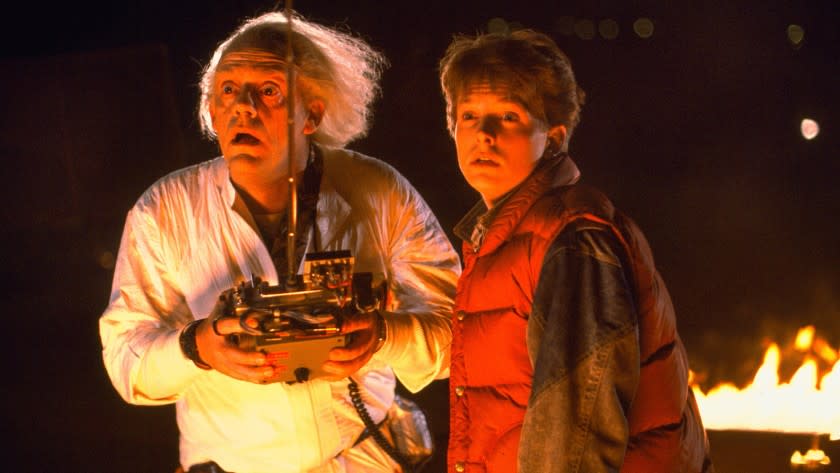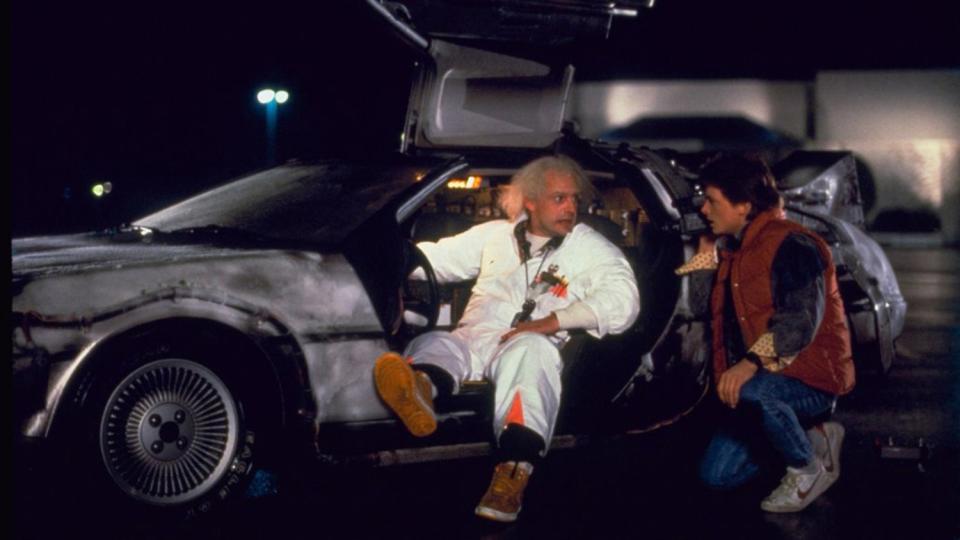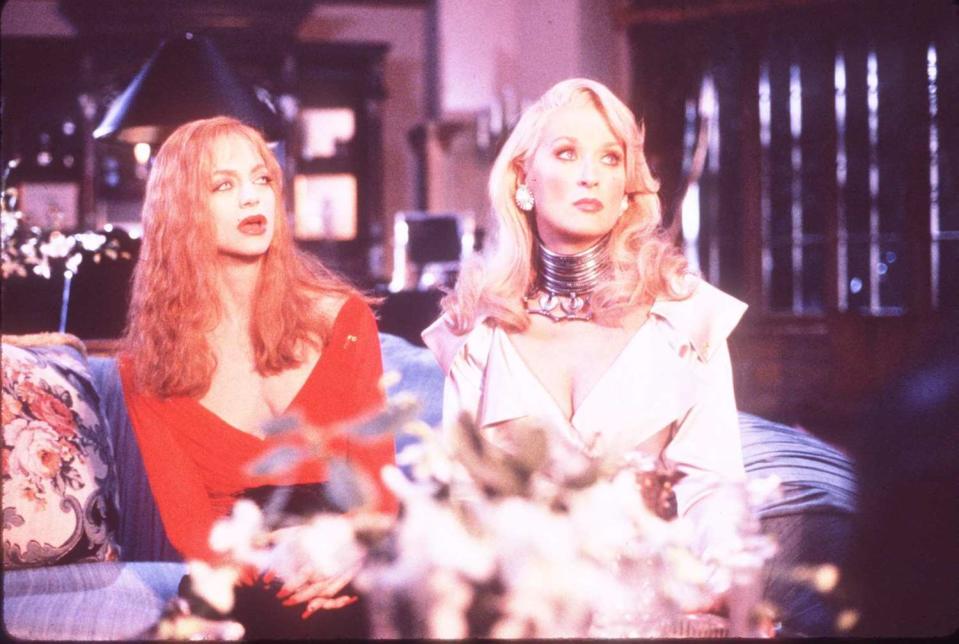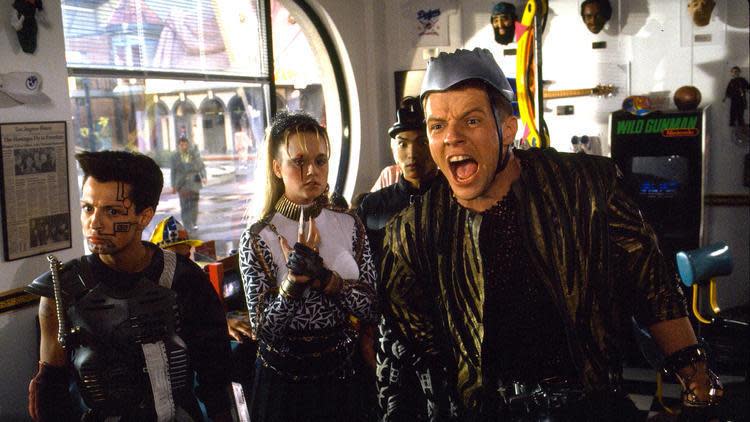Has 'Back to the Future' aged well? Our critics take a closer look at a summer fave

The #UltimateSummerMovie Showdown is under way, and voters have chosen “Back to the Future” (1985) as their winner for Week 10, dedicated to movies first released in theaters from July 3-9 (between 1975 and 2019). Times film writers Justin Chang and Mark Olsen sat down to discuss the enduring popularity of Robert Zemeckis’ time-travel adventure-comedy, and the ways in which time has — and hasn't — been kind to it.
JUSTIN CHANG: Quite a whiplash-inducing thing, Mark, this Ultimate Summer Movie Showdown. Just last week, our colleague Glenn Whipp and I were busy extolling Spike Lee’s “Do the Right Thing,” a movie whose searing truths felt timely in 1989 and feel timelier than ever now. This week, you and I are turning back the clock further and taking on Robert Zemeckis’ “Back to the Future” (1985), a giddily entertaining Reagan-era nostalgia machine that is pretty much the opposite of searing, and which turns the very notion of timeliness on its head.
There’s nothing inherently wrong with that, of course. Watching Marty McFly hop into the DeLorean this week for the umpteenth time or so, I was reminded of all the reasons why this movie remains so beloved by its fans, even if I can’t personally count myself among them. It strikes me, as it always has, as a delirious narrative contraption first and foremost — a clever puzzle whose every twist and payoff has been engineered with clockwork precision. That precision is the source of the movie’s pleasure as well as its limitations: It’s such a niftily executed parlor trick that you can almost (almost!) let some of the story’s creepier subtexts about race, sexual assault and almost-but-thankfully-not-quite-incest pass by unremarked.
The movie is, for better and sometimes for worse, a rich, fascinating document of the era that produced it. President Reagan was famously a huge fan, and not just because we see one of his films — “Cattle Queen of Montana,” the 1954 Western in which he starred opposite Barbara Stanwyck — being advertised on a 1955 Hill Valley theater marquee. With its extended flashback to the ’50s from the vantage of the ’80s, “Back to the Future” taps into the very ethos of the Reagan presidency, or part of it anyway: a spirit of pioneering technological advancement married to a wellspring of nostalgia for ostensibly simpler times.
And yet if we must dive into the movie’s politics, one twist seems unignorable in its prescience. Back in 2015, the year in which many events from “Back to the Future: Part II” takes place, Zemeckis' co-writer, Bob Gale, revealed that Biff Tannen (played by Thomas F. Wilson), the story’s rapey, bullying villain, had been inspired by none other than Donald Trump. I know I’m not alone in wishing we could all bust out of this particular timeline, now that we know what it means to live in a world where Biff has won.

MARK OLSEN: It is true that a lot more than just four years separates “Do The Right Thing” from “Back to the Future.” But there is something exciting about them both being considered as part of our Summer Movie Showdown, as I know for myself I think of summer movies as a kind of narrowly focused action spectacle more in line with the movie “BttF” defeated this week, James Cameron’s 1991 “Terminator 2: Judgment Day.” Loud, effects-driven, relentlessly paced and perhaps even a touch misanthropic, as if driven to the edge by the heat, summer movies can be curiously cold and unlovable, as much as we love them. So “Back to the Future,” a movie that's nothing if not insistently likable, feels in its own way unique to the list.
Like you, Justin, I have always been a little uncomfortable with how much “Back to the Future” demands us to overlook — the bit of business about Marty McFly traveling back in time to inspire Chuck Berry who would in turn inspire the future Marty has always particularly bothered me as an unnecessary filigree. Yet the movie is just trying to have fun with the time-travel paradoxes its story line inevitably sets up, most successfully in the discomforting flirtation between Marty and his future mother, Lorraine, played by Lea Thompson. The movie manages to tiptoe its way up to being truly uncomfortable but then pulls back in a way that has the audience and its characters all breathing a sigh of relief.
It’s still a surprise to learn that Zemeckis and Gale had a hard time setting up “Back to the Future” — Zemeckis has said he has a file with rejection letters from every studio in Hollywood, some even more than once — considering what a part of our pop-culture firmament the movie has become, an obvious and unassailable hit. Finally able to make the film off the success of his third feature, “Romancing the Stone,” Zemeckis revealed himself as a talent that is still very rare, a mix of technician and storyteller in which neither overtakes the other.
From “Who Framed Roger Rabbit” to “Death Becomes Her” to “Flight,” Zemeckis has remained one of the most technically inventive filmmakers in Hollywood while also being an emotionally centered storyteller. And “Back to the Future” displays that beautifully, as the effects of the time-traveling DeLorean still look believable even today without distracting from the events around it. Zemeckis also gets wonderful performances out of his young cast, including the wide-eyed wonder of Michael J. Fox, the effervescence of Thompson and the weirdo wizardry of Crispin Glover. And of course, Christopher Lloyd as a scientist who sets the events in motion in two separate eras.
For a movie that feels so rooted in its moment, a quintessential definition of the throwback “morning in America” nostalgia of the Reaganoid ’80s, there is something timeless about the film as well. It is fun, in the way I think many of us want our summer movies to be, a break from the heat of the season and the worries of the outside world.

CHANG: To put it rather less eloquently than you did, Mark: The damn thing just works. And for all my misgivings, it would be disingenuous of me not to acknowledge the chills I got as I watched Doc once again harness the power of lightning to send Marty on his merry way back to a new-and-improved 1985, all with Alan Silvestri’s infernally catchy score ringing in my ears. I’ve never seen “Back to the Future” on a big screen — I suspect it might mean more to me if I had — but that’s precisely the kind of moment I can imagine taking an entire theater’s (nay, an entire generation’s) worth of moviegoers captive.
You could call this pure escapism, I guess, and in its best moments the movie really does prove worthy of that designation. (Though I haven’t seen it in years, my recollection of “Back to the Future Part II” is that it rises to that level with even more deliriously entertaining consistency.) But as you noted, Mark, Zemeckis also requires us to overlook quite a bit for our pleasure and to put aside some not-inconsiderable reservations. Even the most transporting fantasies don’t exist in a total vacuum. (Sometimes they can take on fresh meaning too: Not long after Marty arrives in 1955, the younger version of Doc warns him, “You must not leave this house. You must not see anybody or talk to anybody.” That’s good advice in any time-travel movie; it also resonates anew in a time of mass quarantine.)
What fascinates me about “Back to the Future” is that some of those cringier moments — Biff’s attack on Lorraine, the Chuck Berry business — are treated as either transitional plot devices or throwaway gags, all served up with the same industrious, look-at-all-the-balls-I’m-juggling smile. This is, after all, Marty’s story, and specifically it’s the story of his desperate efforts to seize back control of his narrative, his existence, his place in the grand scheme of things. Everyone else, for better or worse, is just an afterthought. There’s another subtext in there somewhere, but I’ll leave it to better minds than mine to tease it out.
The intertwining of greatness and mediocrity, of innovation and compromise, is nothing new in Zemeckis’ work, and it’s what makes him such a singularly fascinating filmmaker — and a much more intriguing one of late, frankly, than either his ’80s “Back to the Future” heyday or his Oscar-hogging “Forrest Gump” (another entry in this week’s Showdown!) would suggest. At his inspired best, his fascination with pushing the technological envelope, with merging live-action characters with zany Hollywood spectacle, can produce a movie as inventive as “Who Framed Roger Rabbit” or as memorably grotesque as “Death Becomes Her.”
In more recent years, his forays into performance-capture technology have yielded dispiriting returns in movies like “The Polar Express” and “Beowulf,” though I maintain a certain reluctant admiration for the intensely personal fixations and sheer what-the-hell perversity of “Welcome to Marwen,” his (understandably) maligned movie from 2018. But the old-school live-action classicist in Zemekis has never really gone away, and he’s actually in pretty good form these days. “Flight” is terrific and underappreciated; so too is “The Walk,” with its transcendently beautiful tightrope finale. And his 2016 espionage drama, “Allied,” starring Brad Pitt and Marion Cotillard, grows in my memory: It’s a stirring tribute to the glories of classic Hollywood, a reminder of the pleasures of going back to — well, the past.

OLSEN: I just absolutely adore Zemeckis’ second film, “Used Cars,” also co-written with Gale, and marvel at how they created something so uproariously cynical and in the space of a few years transitioned to something as optimistic as “Back to the Future.” (And I think we are both really looking forward to his upcoming version of Roald Dahl’s “The Witches,” previously adapted by Nicolas Roeg.) To see a filmmaker like Zemeckis continue to push himself, to try new things when he could easily coast or even just walk away, is in and of itself exciting.
That the future isn’t fixed, that our fates can still somehow be altered, is at the core of the space-time continuum as depicted in “Back to the Future.” The sad-sack version of the McFly family we meet at the movie’s beginning, ground down by life, is altered to something more promising when audiences meet them again after Marty’s return. (Though the fact that there is still a winners-vs.-losers zero-sum vision of life is perhaps a vestige of the darker worldview that created “Used Cars.”)
Despite whatever reservations we may both have about “Back to the Future,” its place here in the continuum of summer movies is well deserved. I can’t help but fixate on the fact that we are well past the 30 years in the future of “Back to the Future Part II,” that traveling back 30 years from now only gets us to 1990. Yes, that’s a pre-internet, pre-cellphone age, which in its own way renders it Mesozoic, but it somehow doesn’t seem quite so far the distance between 1955 and 1985 was when Doc Brown fired up the flux capacitor. (Or maybe I’m just showing my age.) The creation of Zemeckis and Gale, their blend of filmmaking innovation and precision-crafted storytelling, seems truly built to last.

